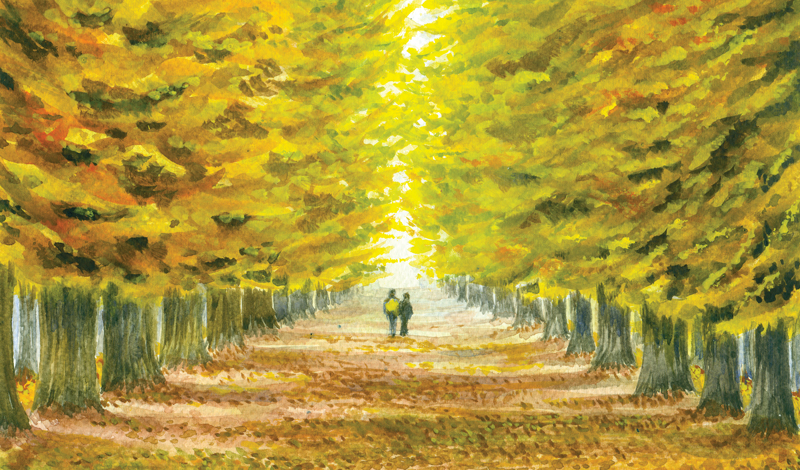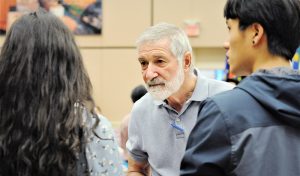The oldest surviving love poem was recorded 4,000 years ago on a cuneiform tablet titled “The Love Song of Shu-Sin” (recited by a bride to her Sumerian king). Today, some of the most relatable love poems are conveyed through song. By one estimate, 100 million songs have been recorded about love, capturing from every angle the first blush of romance and its exhilarating highs to its unrequited, painful and even tragic lows. Whereas Ella and Louie promise “Our Love Is Here to Stay,” Taylor Swift assures “We Are Never Ever Getting Back Together.” If Percy Sledge intones what happens “When a Man Loves a Woman,” Tina Turner ponders “What’s Love Got to Do With It?” after all.
What then does Buddhism say about love in all its iterations—falling in it, staying in it, consciously (or unconsciously) uncoupling from it and reeling from the heartbreak of it? A lot, actually. Let’s delve into the Buddhist view of love.
Happiness Cannot Be Given to Us
First, a reality check: Buddhism teaches that happiness is not something another person can give us. We must build it ourselves, starting with a strong inner core.
In Musashi, the novel’s hero, the swordsman Miyamoto Musashi, gazes at Mount Fuji and tells his young student:
Rather than worrying about your future, thinking, “Perhaps I should become this. Perhaps I should become that,” first be still and build a self that is as solid and unmoving as Mount Fuji.[1]
Relationships are an inevitable part of being alive. And so developing a strong inner core while learning how to develop healthy, long-lasting relationships are keys to leading happy, fulfilling lives.
We do just that by leaning in to our Buddhist practice for self and others, and continually polishing our lives. In the process, we can become people of depth and substance who are not only capable of giving and receiving authentic love—the kind that endures long past the romanticized, blissful state upsold in romantic comedies—but who can contribute to the betterment of all. This process never ends. Ikeda Sensei explains why doing this inner work is so important, saying, “Ultimately, the relationships you form are a reflection of your own state of life.”[2] In that sense, if we have a checklist of the qualities that make for an ideal partner, we must first develop those qualities ourselves.
Indicators of Love
“Love is blind,” the saying goes. While love can be a great font of inspiration, it’s easy to lose all objectivity when falling in love. And while it’s a complex matter that can’t be solved by checking off boxes, there are indicators of what a healthy, mutually supportive relationship looks like at any stage. Consider these, gleaned from Ikeda Sensei’s guidance.
1) We share the same dream. When Marie and Pierre Curie discovered the elements polonium and radium, the latter gave up his own research to support the process of having the elements officially recognized. The stage of their groundbreaking endeavors was a drafty shed that Marie later described as the place where they spent the best years of their lives.[3]
In the same vein, the celebrated novelist Antoine de Saint-Exupéry observed:
Love does not consist in gazing at each other but in looking outward together in the same direction. There is no comradeship except through union in the same high effort.[4]
When we uphold a common vision for what kind of people we want to be and what type of family and society we want to create, that vision enables us to always move forward, mutually inspiring one another, sharing our joys and sorrows along the way.
As Soka Gakkai Buddhists, the ultimate dream we share is kosen-rufu, that is, to spread widely the practice of chanting Nam-myoho-renge-kyo and thereby elevate the life state of humanity. When we live with this pledge at our core, we can transform even the most painful circumstances into the fuel for value and victory.
2) The love we possess is boundless. Falling in love can be exhilarating, filling our days with a drama and excitement that are normally absent from daily life. Sometimes, however, couples can build an island, where without the other, neither is complete. If, as a result, we veer from our chosen path, Sensei explains that love becomes mere escapism.[5]
Buddhism teaches that just like all our other qualities, the love we possess is boundless; it equates to the Buddhist ideal of compassion. Rather than view this as a limited resource to be shared sparingly, authentic love powers our commitment to support others and enables us to grow ever more human in the process. Sensei elaborates:
If you genuinely love someone, then through your relationship with [them], you can develop into a person whose love extends to all humanity. Such a relationship serves to strengthen, elevate and enrich your inner realm of life.[6]
3) We can grow together. Having a partner in life can bring us great meaning and fulfillment. The question we should ask is whether our partner inspires us to be better or distracts from our growth.
Sensei describes a healthy relationship as “one in which two people encourage each other to reach their respective goals while sharing each other’s hopes and dreams. A relationship should be a source of inspiration, invigoration and hope.”[7]
If we stop growing and compromise our dreams, we’ll be left with regrets and may even blame our partner for our shortcomings. So, perhaps, the question we should always ask ourselves is, Am I challenging my own growth?
Is This Person Right for Me?
It takes time to get to know another person. While, ultimately, whom we choose to love is a personal decision, chanting to the Gohonzon gives us the wisdom to see our lives clearly.
In no way should we pressure ourselves with artificial timelines toward starting a relationship or getting married. Sensei, in fact, advises:
There is no need to rush into anything; you don’t need to be in a hurry. … If there is someone you like, what’s wrong with holding on to that feeling inside your heart for a while and resolving to polish yourself so that you can become the kind of person he or she, or anyone, would be proud to be with? Such a spirit of self-development is most admirable, I feel.
Whether or not that person ever learns how you feel in your heart, with time those feelings will grow and mature like a fine wine.[8]
Romantic relationships can help us more deeply reveal what is in our hearts and what we truly desire. Such relationships, as well as all our other relationships, are wonderful avenues for strengthening our character and becoming more considerate, appreciative and mature in our interactions with those around us. It isn’t the relationship itself but the growth we experience through a good relationship that makes us happy.
The Chinese characters for human revolution, the type of growth being described, depict change occurring in the space between people. In other words, we “grow and mature like fine wine” through our interactions with others.
Standing Up to Heartbreak
It goes without saying that some of the most iconic love songs are about heartache. (The Spotify playlist “Broken Heart” has 3 million likes for a reason.) Some people feel as though their lives have lost all meaning when a relationship ends or their hearts are broken. Sensei addresses this, saying:
I’m sure quite a few among you have had your hearts broken or been badly hurt and perhaps felt unable to go on, your self-esteem in tatters. But you must never believe that you are worthless. There is no substitute for you, who [is] more precious than all the treasures in the universe. …
It is crucial that you become strong. If you are strong, even your sadness will become a source of nourishment, and the things that make you suffer will purify your lives.
Only when we experience the crushing, painful depths of suffering can we begin to understand the true meaning of life. Precisely because we have experienced great suffering, it is imperative that we go on living.
The important thing is to keep moving forward. If each of you uses your sadness as a source of growth, you will become a person of greater depth and breadth—an even more wonderful you.[9]
It’s times like these that call for a new tune. As Buddhists, the best love song we can sing to ourselves is Nam-myoho-renge-kyo, through which we bow deeply to our own Buddha nature and call forth endless reserves of wisdom, courage and compassion to face every obstacle with an undefeatable spirit.
The Key to True Happiness Is Faith
The honeymoon is a distant memory, the romantic dinners have been swapped with dirty diapers and anxiety over bills, and it’s now crystal clear: marriage doesn’t equal bliss, regardless of what the wedding planner said.
Sensei explains clearly that whether a marriage is happy or not depends on the effort two people put into it:
With marriage your circumstances will change, but that does not mean that your personal destiny or karma have changed. No matter where or with whom you live, if illness is your fate, you will still fall ill. And if economic hardship is your karma, you cannot escape it.
The important thing, then, is how to break such negative karma or destiny. You have to develop the life force necessary to serenely overcome whatever hardships you may face, to never be defeated by them. Faith is the source of that strength. The true key to happiness is faith.[10]
The purpose of life is to become happy—so happy, in fact, that living itself is a joy. We practice Buddhism to realize this ultimate aim. As Buddhists, our relationships serve as a mirror to polish ourselves, deepen our happiness and fulfill our mission as Bodhisattvas of the Earth, striving to uplift humanity. It’s up to us to decide which tune we sing.
—Prepared by the Living Buddhism staff.
References
- Translated from Japanese. Eiji Yoshikawa, Miyamoto Musashi (Tokyo: Rokko Shuppan-bu, 1965), vol. 5, p. 8. ↩︎
- Discussions on Youth, p. 65. ↩︎
- www.nobelprize.org/prizes/themes/marie-and-pierre-curie-and-the-discovery-of-polonium-and-radium <accessed on August 17, 2021>. ↩︎
- Antoine de Saint-Exupéry, Airman’s Odyssey (Orlando: Harcourt, 1984), p. 195. ↩︎
- Discussions on Youth, p. 64. ↩︎
- Ibid, p. 65. ↩︎
- Ibid., p. 60. ↩︎
- Ibid., p. 70. ↩︎
- Ibid., p. 69. ↩︎
- The New Human Revolution, vol. 5, p. 78. ↩︎
You are reading {{ meterCount }} of {{ meterMax }} free premium articles





